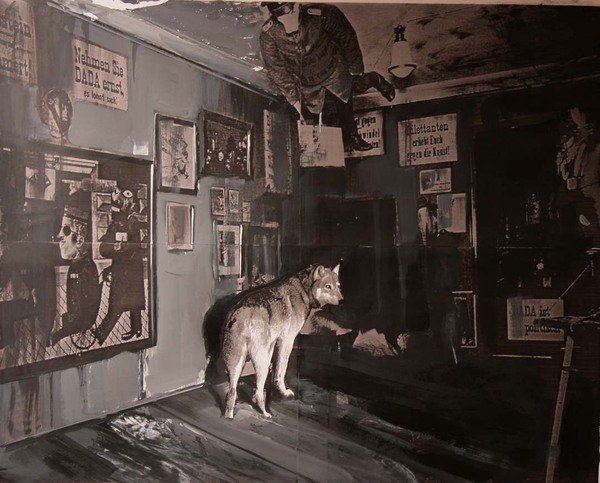The Punishment of Lust and Luxury
dal 23/1/2009 al 27/2/2009
Segnalato da
23/1/2009
The Punishment of Lust and Luxury
Nicodim Gallery, Los Angeles
An exhibition curated by Jane Neal and featuring the work of Cyprien Gaillard, Adrian Ghenie, Ciprian Muresan and Martin Skauen. The inspiration for the title of the show derives from a painting by Giovani Segantini. The works on display either addresses his life, the moral and ethical questions arising from the issues surrounding culpability and punishment, or the nightmarish consequences of the human desire for order, restitution and power.

Curated by Jane Neal
Mihai Nicodim Gallery is proud to present: The Punishment of Lust and Luxury; an exhibition curated by Jane Neal and featuring the work of Cyprien Gaillard, Adrian Ghenie, Ciprian Muresan and Martin Skauen.
The inspiration for the title of the show derives from a painting by the 19th Century Italian artist Giovani Segantini. A member of the Divisionist group and credited by Kandinsky as being ‘one of the forerunners of spirituality in art’, Segantini was greatly admired by Munch, van Gogh and Ensor. Segantini lost his mother when he was a small boy and whether it was the trauma of this, the influence of his Catholic background, or (in common with a growing number of leading European writers and artists who were beginning to realise art could be an effective means of exposing social injustice), a desire to hi-light the mistreatment of children, the artist embarked upon a series of works about bad mothers of which ‘The punishment of Lust’ (1891) is the best known. The work hangs in the Walker art collection in Liverpool, but not under its original name; shortly after the Museum acquired the painting, the board of trustees demanded it be renamed ‘The Punishment of Luxury’ because the original title was felt to be too controversial.
While the title of Segantini’s work is an intriguing topic for exploration, so is the artist’s own story, his involvement with the Divisionist group, and the controversy his work stirred regarding the concept of ‘bad mothers’. The notion of bad parenting has never had more currency – western society obsesses over what it means to be a good or bad parent; yet despite the advent of feminism and the supposed advancement of sexual equality, still the worst crime to be accused of is to be a wicked mother. So the Walker decided (with a certain foresight as it turned out) to focus the public’s attention on the more palatable vice of luxury. Given that the genesis for this exhibition began some time before the credit crunch entered the global vocabulary, it is weirdly pertinent that the notion of the punishment of luxury has suddenly become especially interesting to explore – both in the context of LA (arguably the world’s capital city for glamour and extravagance), and, at this time of global financial crisis where a drive to find answers and scapegoats is providing the western world’s press with an excuse for prurience, and the companies who survive the global economic downturn with more power and less competition.
Many disparate public and political voices across the world have argued that there should be a ‘call to account’. The question is, should we individually take this opportunity to reflect and examine our personal motives? And if there is cause for public recriminations, who is to judge and meter our punishment and who will draw the line? Throughout cross-cultural, geographical and political history, art and literature have posed and reposed this question - and for the most part the basic format of the story remains unchanged: the hero is warned not to be seduced from his rightful path; he inevitably strays and learns an important lesson from so doing – but not without first enduring perilous trials, or encountering unpleasant characters and situations. Sometimes, if the artist or author is particularly keen to drive the point home, the hero may even lose his love or his life in order to secure his redemption (if his sins are suitably grave). In our age of relativism, we have almost forgotten the concept of paying our dues – but is there something inbuilt within our psyches that demands we remember?
The four artists in this exhibition will present work that either addresses Segantini’s life and his painting, the moral and ethical questions arising from the issues surrounding culpability and punishment, or the nightmarish consequences of the human desire for order, restitution and power. We will see how even the most banal of activities can become a form of torture should an activity be prolonged sufficiently as to induce suffering in the participant, and witness the erosion of sanity once an obsession is allowed to take hold.
Cyprien Gaillard has been widely exhibited throughout Europe, the Fifth Berlin Biennale and the Athens Biennale among others.
Martin Skauen was also featured in the Athens Biennale in 2008, has had a solo show at Kunstlerhaus Bathanien in Berlin and is currently showing at Laura Bartlett in London.
Ciprian Muresan was featured in the last two editions of Prague Biennale, Athens Biennale in 2008 and had solo shows at Mihai Nicodim Gallery in Los Angeles and Plan B, Cluj, Romania and Berlin.
Adrian Ghenie is currently featured in the Liverpool Biennale, had solo shows at Haunch of Venison, Zurich, Mihai Nicodim, Los Angeles and Nolan Judin, Berlin. His next solo show at Haunch of Venison, London will take place in May 2009 and at Mihai Nicodim, Los Angeles in November 2009.
Both Ciprian Muresan and Ciprien Gaillard will be featured in the upcoming triennial “Younger Than Jesus” organized by the New Museum in New York in April 2009.
Image: Adrian Ghenie
Opening reception: Saturday, January 24, 6 – 8 pm
Nicodim Gallery
944 Chung King Rd - Los Angeles
Free admission



